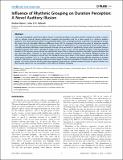Influence of Rhythmic Grouping on Duration Perception: A Novel Auditory Illusion
Author(s)
Geiser, Eveline; Gabrieli, John D. E.
DownloadGeiser-2013-Influence of rhythmi.pdf (197.7Kb)
PUBLISHER_CC
Publisher with Creative Commons License
Creative Commons Attribution
Terms of use
Metadata
Show full item recordAbstract
This study investigated a potential auditory illusion in duration perception induced by rhythmic temporal contexts. Listeners with or without musical training performed a duration discrimination task for a silent period in a rhythmic auditory sequence. The critical temporal interval was presented either within a perceptual group or between two perceptual groups. We report the just-noticeable difference (difference limen, DL) for temporal intervals and the point of subjective equality (PSE) derived from individual psychometric functions based on performance of a two-alternative forced choice task. In musically untrained individuals, equal temporal intervals were perceived as significantly longer when presented between perceptual groups than within a perceptual group (109.25% versus 102.5% of the standard duration). Only the perceived duration of the between-group interval was significantly longer than its objective duration. Musically trained individuals did not show this effect. However, in both musically trained and untrained individuals, the relative difference limens for discriminating the comparison interval from the standard interval were larger in the between-groups condition than in the within-group condition (7.3% vs. 5.6% of the standard duration). Thus, rhythmic grouping affected sensitivity to duration changes in all listeners, with duration differences being harder to detect at boundaries of rhythm groups than within rhythm groups. Our results show for the first time that temporal Gestalt induces auditory duration illusions in typical listeners, but that musical experts are not susceptible to this effect of rhythmic grouping.
Date issued
2013-01Department
Massachusetts Institute of Technology. Department of Brain and Cognitive Sciences; McGovern Institute for Brain Research at MITJournal
PLoS ONE
Publisher
Public Library of Science
Citation
Geiser, Eveline, and John D. E. Gabrieli. “Influence of Rhythmic Grouping on Duration Perception: A Novel Auditory Illusion.” Ed. Warren H. Meck. PLoS ONE 8.1 (2013).
Version: Final published version
ISSN
1932-6203